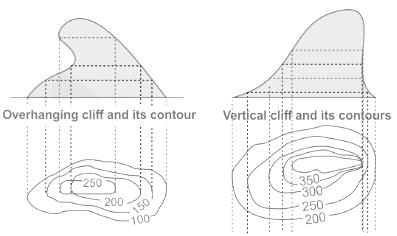Civil Engineering (CE) Exam > Civil Engineering (CE) Questions > Contours of different elevations do not unite...
Start Learning for Free
Contours of different elevations do not unite to form one contour except in case of a
- a)Pond
- b)Vertical cliff
- c)Ridge
- d)Valley
Correct answer is option 'B'. Can you explain this answer?
Verified Answer
Contours of different elevations do not unite to form one contour exce...

Contours of different elevation unite to form one line only in the case of Vertical cliff.
Most Upvoted Answer
Contours of different elevations do not unite to form one contour exce...
Understanding Contours and Their Formation
Contours are lines on a map that connect points of equal elevation. They help in visualizing the topography of an area. However, these lines behave differently based on the landscape features.
Why Contours Unite in a Vertical Cliff
- Definition of a Vertical Cliff: A vertical cliff represents a sudden change in elevation. It is characterized by its steep, nearly vertical face.
- Contour Behavior:
- In the case of a vertical cliff, the contours will unite or overlap at the edge of the cliff. This happens because the elevation changes abruptly from one level to another.
- Since there are no intermediate elevations between the top and bottom of the cliff, the contours represent the same elevation at the cliff's edge.
Other Options Explained
- Pond:
- Contours around a pond will generally close in on themselves but will not unite to form a single line, as the water surface remains at a constant elevation.
- Ridge:
- On a ridge, contours are typically spaced apart, indicating a gradual slope. They do not unite as different elevations exist along the ridge.
- Valley:
- In a valley, the contours form V-shapes pointing uphill, and again do not unite since they represent varying elevations within the valley.
Conclusion
In summary, the only scenario where contours of different elevations unite is in the case of a vertical cliff. This characteristic makes option 'B' the correct answer. Understanding these topographical features is crucial in civil engineering for effective planning and design.
Contours are lines on a map that connect points of equal elevation. They help in visualizing the topography of an area. However, these lines behave differently based on the landscape features.
Why Contours Unite in a Vertical Cliff
- Definition of a Vertical Cliff: A vertical cliff represents a sudden change in elevation. It is characterized by its steep, nearly vertical face.
- Contour Behavior:
- In the case of a vertical cliff, the contours will unite or overlap at the edge of the cliff. This happens because the elevation changes abruptly from one level to another.
- Since there are no intermediate elevations between the top and bottom of the cliff, the contours represent the same elevation at the cliff's edge.
Other Options Explained
- Pond:
- Contours around a pond will generally close in on themselves but will not unite to form a single line, as the water surface remains at a constant elevation.
- Ridge:
- On a ridge, contours are typically spaced apart, indicating a gradual slope. They do not unite as different elevations exist along the ridge.
- Valley:
- In a valley, the contours form V-shapes pointing uphill, and again do not unite since they represent varying elevations within the valley.
Conclusion
In summary, the only scenario where contours of different elevations unite is in the case of a vertical cliff. This characteristic makes option 'B' the correct answer. Understanding these topographical features is crucial in civil engineering for effective planning and design.

|
Explore Courses for Civil Engineering (CE) exam
|

|
Question Description
Contours of different elevations do not unite to form one contour except in case of aa)Pondb)Vertical cliffc)Ridged)ValleyCorrect answer is option 'B'. Can you explain this answer? for Civil Engineering (CE) 2025 is part of Civil Engineering (CE) preparation. The Question and answers have been prepared according to the Civil Engineering (CE) exam syllabus. Information about Contours of different elevations do not unite to form one contour except in case of aa)Pondb)Vertical cliffc)Ridged)ValleyCorrect answer is option 'B'. Can you explain this answer? covers all topics & solutions for Civil Engineering (CE) 2025 Exam. Find important definitions, questions, meanings, examples, exercises and tests below for Contours of different elevations do not unite to form one contour except in case of aa)Pondb)Vertical cliffc)Ridged)ValleyCorrect answer is option 'B'. Can you explain this answer?.
Contours of different elevations do not unite to form one contour except in case of aa)Pondb)Vertical cliffc)Ridged)ValleyCorrect answer is option 'B'. Can you explain this answer? for Civil Engineering (CE) 2025 is part of Civil Engineering (CE) preparation. The Question and answers have been prepared according to the Civil Engineering (CE) exam syllabus. Information about Contours of different elevations do not unite to form one contour except in case of aa)Pondb)Vertical cliffc)Ridged)ValleyCorrect answer is option 'B'. Can you explain this answer? covers all topics & solutions for Civil Engineering (CE) 2025 Exam. Find important definitions, questions, meanings, examples, exercises and tests below for Contours of different elevations do not unite to form one contour except in case of aa)Pondb)Vertical cliffc)Ridged)ValleyCorrect answer is option 'B'. Can you explain this answer?.
Solutions for Contours of different elevations do not unite to form one contour except in case of aa)Pondb)Vertical cliffc)Ridged)ValleyCorrect answer is option 'B'. Can you explain this answer? in English & in Hindi are available as part of our courses for Civil Engineering (CE).
Download more important topics, notes, lectures and mock test series for Civil Engineering (CE) Exam by signing up for free.
Here you can find the meaning of Contours of different elevations do not unite to form one contour except in case of aa)Pondb)Vertical cliffc)Ridged)ValleyCorrect answer is option 'B'. Can you explain this answer? defined & explained in the simplest way possible. Besides giving the explanation of
Contours of different elevations do not unite to form one contour except in case of aa)Pondb)Vertical cliffc)Ridged)ValleyCorrect answer is option 'B'. Can you explain this answer?, a detailed solution for Contours of different elevations do not unite to form one contour except in case of aa)Pondb)Vertical cliffc)Ridged)ValleyCorrect answer is option 'B'. Can you explain this answer? has been provided alongside types of Contours of different elevations do not unite to form one contour except in case of aa)Pondb)Vertical cliffc)Ridged)ValleyCorrect answer is option 'B'. Can you explain this answer? theory, EduRev gives you an
ample number of questions to practice Contours of different elevations do not unite to form one contour except in case of aa)Pondb)Vertical cliffc)Ridged)ValleyCorrect answer is option 'B'. Can you explain this answer? tests, examples and also practice Civil Engineering (CE) tests.

|
Explore Courses for Civil Engineering (CE) exam
|

|
Signup for Free!
Signup to see your scores go up within 7 days! Learn & Practice with 1000+ FREE Notes, Videos & Tests.


















